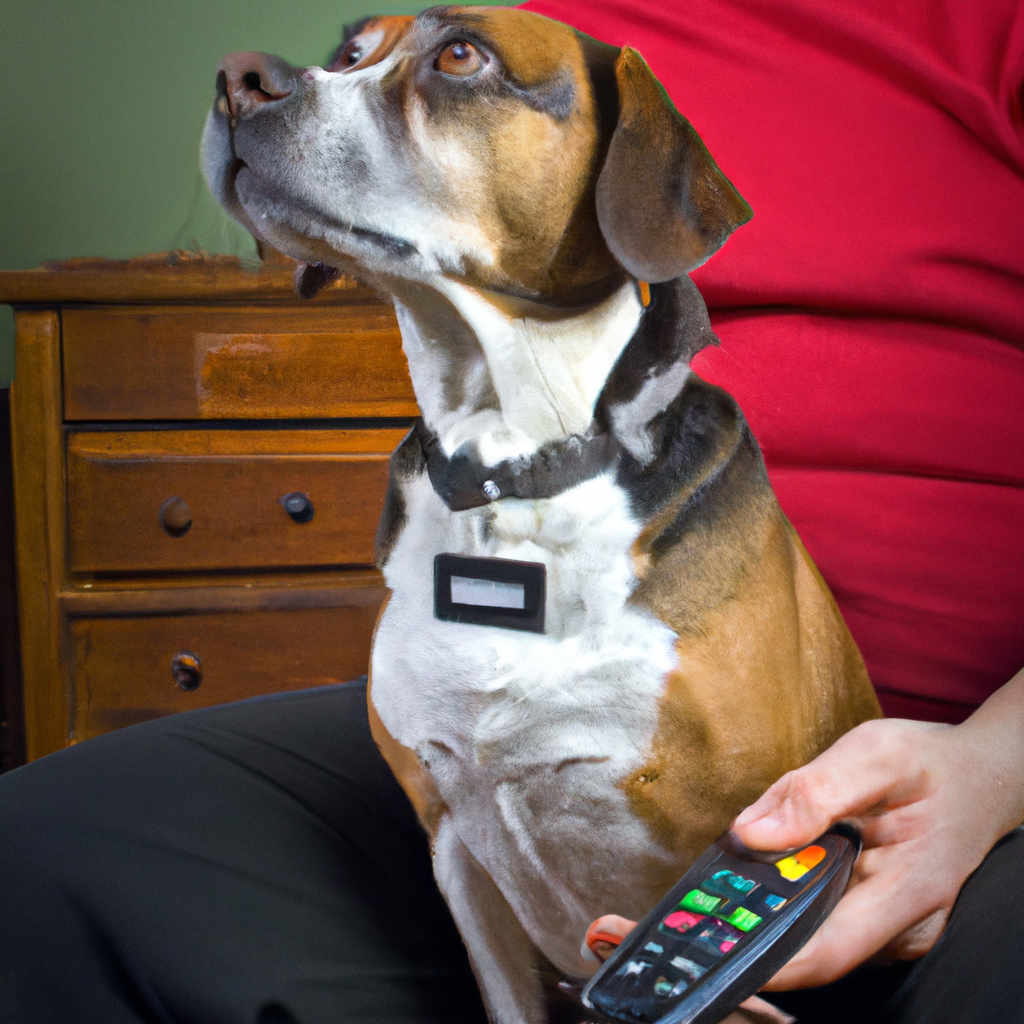Welcome to the world of shock collars for obedience training. If you're new to this, you might have some doubts, confusion, or even fear about using a shock collar on your furry friend. However, when used correctly, shock collars can be an effective tool for teaching obedience to your dog.
First and foremost, it's essential to know that shock collars should never be used to punish or harm your dog. They should only be used as a last resort when other training methods have failed. Shock collars work by delivering a mild electric shock to your dog's neck, which gets their attention and interrupts their behavior. When used correctly, the collar can reinforce positive behavior and correct negative behavior without causing pain or harm. So, let's dive into some tips on how to use shock collar for obedience training.
As an Amazon Associate, we earn from qualifying purchases
Key Takeaways: How to Use Shock Collar for Obedience
- Begin by familiarizing yourself with the shock collar's manual and instructions for proper usage.
- Fit the collar correctly on your dog's neck, ensuring it is snug but not too tight.
- Make sure your dog is comfortable wearing the collar before initiating any training sessions.
- Start with the lowest shock setting and gradually increase it if necessary.
- Use the shock sparingly and as a last resort, relying more on positive reinforcement techniques.
- Focus on teaching your dog basic obedience commands and reinforce them with treats and praise.
- Avoid using the shock collar as a punishment tool and instead use it as a training aid.
- Always monitor your dog's reaction and adjust the intensity of the shock accordingly.
- Be patient and consistent with the training process, and seek guidance from a professional dog trainer if needed.
Choose the Right Shock Collar
When it comes to choosing the right shock collar for your dog, it's important to consider the size, temperament, and features of different shock collars.


Consider Your Dog's Size and Temperament
With so many shock collars for training on the market, it can be difficult to know which one is right for your dog. It's essential to choose a collar that is appropriate for your dog's size and behavior to ensure their safety and comfort.
If you have a small dog, you'll want to choose a shock collar that is lightweight and compact. A collar that is too heavy or cumbersome can be uncomfortable and even harmful to a small dog. On the other hand, if you have a large dog, you'll need a collar that is strong and durable enough to withstand its strength and energy.
Your dog's temperament is also an important consideration. Some dogs are more sensitive to stimulation than others, so you'll want to choose a collar with adjustable levels of stimulation. This will allow you to tailor the shock to your dog's individual needs and avoid overstimulation. Additionally, if your dog is particularly stubborn or aggressive, you may want to consider a collar with a higher level of stimulation. By taking your dog's size and temperament into account, you can choose a shock collar that is safe, effective, and appropriate for your furry friend.
Evaluate the Features of Different Shock Collars
First, consider the range of the collar. If you plan on using the collar for off-leash training, you'll want a collar with a longer range. Additionally, some collars offer GPS tracking and other features that can be helpful for certain situations.
Next, evaluate the type of stimulation the collar provides. Some collars offer a vibration or tone option in addition to the shock, which can be useful for dogs that may not respond well to just the shock. Finally, look for a collar with a rechargeable battery to save money in the long run and avoid the hassle of replacing batteries.
When evaluating the features of different shock collars, it's important to keep your dog's needs in mind. Don't be afraid to ask for recommendations from other dog owners or professionals, as they may have experience with certain brands or features that could be beneficial for your dog. With a little research and consideration, you can choose a shock collar that will help you train your furry friend in a safe and effective way.
Choose a Collar with Adjustable Levels of Stimulation
One important feature to consider is the level of stimulation that the collar provides. It is important to choose a collar with adjustable levels of stimulation to ensure that you can find the right level for your dog's needs.
Adjustable levels of stimulation allow you to customize the intensity of the shock that your dog receives. This is important because different dogs have different tolerances for stimulation. Some may only need a low level of shock to respond to commands, while others may require a higher level.
By choosing a collar with adjustable levels of stimulation, you can find the right level for your dog without causing unnecessary discomfort or harm.


Familiarize Your Dog with the Collar
To familiarize your dog with the collar, it's important to introduce it gradually. Start by letting your dog explore the collar on their own terms, allowing them to sniff and investigate. Once they seem comfortable, give treats and praise to build trust and positive associations with the collar. By taking the time to properly introduce the collar, you can ensure that your dog feels safe and comfortable wearing it.
Introduce the Collar Gradually
Start by simply placing the collar near your dog without putting it on them. Allow them to sniff and explore it at their own pace. This will help them to become familiar with the collar and reduce any fear or anxiety they may have towards it. Once they seem comfortable with the collar being near them, you can start putting it on for short periods of time, gradually increasing the amount of time they wear it.
Remember to always monitor your dog's behavior during this process and be patient with them. It may take some time for them to get used to the collar, but with patience and positive reinforcement, they will eventually become comfortable wearing it.
By taking the time to introduce the collar gradually, you are ensuring a positive and stress-free experience for both you and your dog.
Give Treats and Praise to Build Trust
Whenever your dog wears the collar, make sure to have a stock of treats on hand. Whenever your dog does something good, such as obeying a command or walking calmly on a leash, give them a treat and praise them. This will help your dog associate the collar with positive experiences and build trust in you as their owner.
It's important to keep in mind that building trust takes time and patience. Don't rush the process, and don't expect your dog to immediately trust the collar.
Set up the Shock Collar
To properly set up the shock collar for how to use shock collar for obedience, the first step is to attach the collar to your pup. It's important to make sure it fits snugly but comfortably, so your furry friend doesn't feel restricted or uncomfortable. Finally, ensure the shock levels are set appropriately for your dog's size and behavior, so they receive the proper amount of correction without causing harm or distress.
Attach the Collar to Your Pup
First, make sure that your pup is calm and relaxed. Gently slide the collar over their head, making sure that their ears are not caught in the process. Once the collar is around their neck, adjust it so that it fits snugly but comfortably. You should be able to fit two fingers between the collar and your pup's neck, but no more.
The collar should sit high on the neck, just below the ears, and not on the lower part of the neck. This position ensures that the collar is secure and won't slide off or put pressure on the dog's throat. Once you have made sure that the collar fits perfectly, you can move on to the next step of setting the appropriate shock levels.
Ensure the Shock Levels Are Set Appropriately
Start by setting the shock intensity to the lowest level and put the collar on your dog. Observe your dog's reaction and behavior. If they seem uncomfortable or startled, then the shock level is too high. Gradually increase the intensity until you find the level that works best for your dog. Keep in mind that every dog is unique and may respond differently to the shock collar. It's crucial to take the time to find the right setting for your pup.
Use Commands to Reinforce Desired Behaviors
Start with basic commands such as “sit,” “stay,” and “come.” Use a firm and clear voice to give the command, and reward your pup with praise or treats when they obey. It's important to be patient and consistent with your commands, as it may take some time for your pup to understand and learn what you want them to do.
As your dog becomes more comfortable with basic commands, you can introduce more advanced ones such as “heel” and “leave it.” These commands can be especially useful when walking your dog or when interacting with other animals. Remember to always use positive reinforcement when your pup obeys a command, and avoid using punishment or physical force. This will help create a positive and trusting relationship between you and your pup.
Reward Desired Behaviors Immediately
When your dog exhibits a desired behavior, such as sitting or coming when called, it is crucial to reward them immediately with a treat or verbal praise. This will reinforce the behavior and encourage them to repeat it in the future.
By rewarding desired behaviors immediately, you are creating a positive and enjoyable training experience for both you and your furry friend.
Use the Shock Collar Consistently
Make sure to use the shock collar every time your dog exhibits unwanted behavior. This will allow your dog to associate the shock with that specific behavior.
Using the shock collar consistently will help your dog understand the boundaries and what behaviors are expected of them. Do not expect immediate results, but with time and consistency, your dog will learn to behave appropriately and respond to your commands.
Monitor Your Dog's Progress
As you continue to monitor your dog's progress, it's important to observe their reactions to the collar. You may need to adjust the settings as needed to ensure their comfort and safety.
Observe Their Reactions to the Collar
Observe how your dog reacts when you activate the collar. Do they seem to be in pain or distress? Do they yelp or flinch? If so, the shock level may be too high and should be adjusted accordingly. On the other hand, if your dog seems unaffected by the shock, the level may need to be increased.
It’s also important to observe your dog’s behavior during training sessions. Are they responding positively to your commands, or do they seem confused and anxious? If your dog is displaying signs of fear or anxiety, it may be necessary to take a step back and reevaluate your training approach.
Adjust the Settings as Needed
After a few training sessions, you may notice that your dog is not responding to the shock collar as you had hoped. This could be due to a number of factors, including the intensity of the shock, the timing of the correction, or the dog's temperament. It's important to remember that every dog is different and may require different settings to achieve the desired results.
In addition to adjusting the intensity of the shock, you may also need to adjust the timing of the correction. Some dogs may respond better to immediate corrections, while others may require a delay. Experiment with different settings and observe your dog's behavior to find the best approach.
Be Patient and Consistent
Consistency is key when it comes to dog training. Make sure to use the collar consistently and in the same manner each time. This will help your dog understand what is expected of them and what commands they need to follow.
Remember, your dog is learning and it's important to be patient and consistent throughout the training process. With time and practice, your dog will learn the new commands and behaviors you're teaching them, and you'll have a well-behaved furry friend by your side.
Proper Care of the Shock Collar
To ensure the longevity and effectiveness of your shock collar, it is important to properly care for it. This includes cleaning and drying the collar after each use, storing it in a safe place, and regularly checking for signs of wear and tear. By following these simple steps, you can keep your shock collar in top condition and continue to use it safely and effectively in your training sessions.
Clean and Dry the Collar After Each Use
To clean the collar, use a damp cloth and mild soap to wipe down the entire collar, including the contact points. Be sure to rinse off any soap residue and dry the collar thoroughly with a clean towel or cloth. Leaving moisture on the collar can cause damage to the electronic components and reduce the effectiveness of the shock.
If the collar is particularly dirty or has a strong odor, you may want to consider using a specialized collar cleaner. These products are designed to remove tough stains and odors without damaging the collar. Always follow the instructions provided by the manufacturer and avoid using harsh chemicals or abrasive materials. With proper cleaning and care, your shock collar will remain in top condition and provide reliable training for years to come.
Store the Collar in a Safe Place
When it comes to storing the collar, make sure to keep it in a safe place where it is not accessible to your dog or any other pets in your household. This is important because if your dog were to accidentally get their paws on the collar, it could potentially damage the collar. Store it in a place that is cool, dry, and away from direct sunlight or heat sources.
It's also a good idea to keep the collar in its original packaging or a designated storage container to protect it from any external factors that could potentially damage it. By taking these simple steps to properly care for and store your shock collar, you can ensure that it remains in good condition and continues to be an effective training tool for your furry friend.
Check the Collar Regularly for Signs of Wear and Tear
Over time, the collar may become damaged due to constant use and exposure to your dog's environment. Check the collar regularly for any signs of cracks or fraying on the collar strap, as well as any damage to the electronic components. If you notice any damage, it's important to replace the collar immediately to ensure your dog's safety and to avoid any malfunction during training sessions.
Conclusion
Now you know How to Use Shock Collar for Obedience training. Using a shock collar for obedience training can be a useful tool for dog owners, but it is important to use it properly and responsibly. Choose the right collar, familiarize your dog with it, and set up boundaries before beginning training. Consistency is key when using the collar, and monitoring your dog's progress is essential to ensure they are not experiencing any negative effects.
Frequently Asked Questions
How do I use a shock collar for obedience training?
To use a shock collar for obedience training, start by fitting the collar properly on your dog. It should be snug, yet comfortable. Next, make sure your dog understands basic obedience commands before introducing the collar. Gradually increase the intensity of the shock, only using it when necessary. Always follow the manufacturer's instructions and consult with a professional dog trainer if needed.
Can I train any dog using a shock collar?
Yes, shock collars can be used to train almost any dog. However, they are most commonly used for medium to large-sized breeds. It's essential to assess your dog's temperament and consult with a professional dog trainer to determine if a shock collar is appropriate for your specific dog.
Are shock collars safe for my dog?
When used correctly and responsibly, shock collars are considered safe. However, it is important to select a high-quality collar and follow the manufacturer's guidelines. Start with the lowest shock setting and observe your dog's reaction. It's crucial to avoid overusing the shock and only utilize it as a last resort for obedience training.
How does a shock collar work?
A shock collar is a training device that delivers a mild electric shock to your dog. It works by transmitting a signal from the remote control to the electronic collar worn by your dog. The shock serves as a deterrent to undesirable behavior, helping your dog associate the behavior with the shock and eventually learn to avoid it.
What are the basic obedience commands I should teach my dog?
A: Some basic obedience commands to teach your dog include sit, stay, come, down, and heel. These commands form the foundation of good behavior and can be effectively reinforced with the use of a shock collar, when used appropriately.
Can I use a shock collar to train hunting dogs?
Yes, shock collars are commonly used in training hunting dogs. They can be a valuable tool for reinforcing commands at a distance, ensuring that your hunting dog stays focused on its training and responds promptly to your instructions.
What precautions should I take when using a shock collar?
When using a shock collar, it's important to ensure that it is properly fitted and not too tight or too loose on your dog's neck. Additionally, always follow the manufacturer's instructions and avoid leaving the collar for longer durations.





